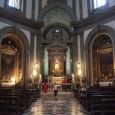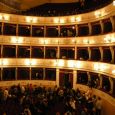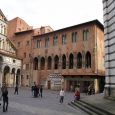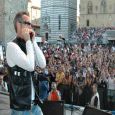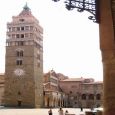Pistoia
Advertisement
By Air
The main international or intercontinental airport facilities closer to town are Florence (30 km), Pisa (75 km) and Rome-Fiumicino (about 340 miles).
By Train
Its station is on the Maria Antonia railway, connecting Florence, Lucca and Viareggio and it is at the southern end of the Porrettana railway, the original line between Florence and Bologna.
By Road
Pistoia is connected to the national motorway network via the Firenze-Mare is easily accessible from the city center with the Motorway of Pistoia. Other important roads that touch the city are the State Road 64 Porrettana that connects the cities of Bologna and Ferrara, Emilia Romagna, the former State Route 66 Pistoiese that connects with both the regional capital with both the National Road 12 Abetone and Brenner and the former State Road 435 that connects with the Lucchese western Tuscany.
By Bus
The local public transport for the city and its province has been run by Blubus Scarl.
Advertisement
Teatro Manzoni
is a theater of Pistoia in Corso Gramsci 127.The origin of the theater is tied to 'Awake' Academy was founded in Pistoia in 1642 by Frederick Noble Manni and Monsignor Felix Clerks in order to contribute to the cultural awakening of the city.After getting a room by the City Council of the Public Palace , which was used only occasionally to the theater hall, the Academy obtained a Tiratoio of ' Art of wool to create a real theater that after long and complex practices of fund raising and project development was finally inaugurated in 1694.In 1998 it also became home of the Tuscan Regional Centre for Dance and its Toscanadanza project aimed at the enhancement and promotion of independent companies active in Tuscany.
Theatre Bolgonini Mauro
is a theater located in Pistoia.The theater, originally called the State Theater, was built in the thirties in the court- yard of the palace of the eighteenth century, where there is also the Municipal Technical Office.The building suffered damage during the last war and in 1958 is already past the property of the Tuscany Region.His last editorial before the restoration work being completed, dates back to the fifties when it was set up the rectangular room with a gallery, a stage in the wooden beams of reinforced concrete that opened up the room with a large proscenium with a curtain and Mantua, and with five dressing rooms arranged on the left side.After a long period of neglect, which caused a serious deterioration, have recently begun work on restructuring and adjustment to return to the activity of this structure theatrical medium.The structure, restored in addition to the traditional theatrical activities, drama and concerts, is also aimed at conferences, civic meetings, seminars with the use of audiovisual projections.In this way, given its central location, is back to being the place appointed for the municipal administration and public cultural events.
Fortress Santa Barbara
is an ancient fortress city of Pistoia.Built on an old fort Medieval erected by the Florentines in 1331 near a chapel dedicated to St. Barnabas and destroyed by Pistoia in retaliation in 1343, retains the great tower and small traces of these ancient structures.It was built by order of Cosimo I de Medici, who assigned the project to Nanni Unghero ; work, which began in 1539, were directed by Giovan Battista Bellucci.The intent was to put an end to the warlike ambitions of Pistoia rather than external threats.The nucleus was enlarged by Bernard Buontalenti that connected it with a new bulwark against the city wall.He was disarmed by the Grand Duke Peter Leopold in 1734, having endured throughout its history only a siege, that of 1643, when troops of the Barberini attacked the city and were rejected.It was later used as barracks, military prison, district.Inside the Germans in 1944 shot four young Pistoia.Date the license to use the city and restored, was opened to the public in 1980.Currently during the summer months there are projections made film.
Museum of Embroidery
is located in the Palazzo Rospigliosi in Pistoia and costodisce and exhibits a collection of embroidery, made from the seventeenth to the twentieth century, and the tools and techniques of the traditional art of embroidery Pistoia.The museum was founded in 2004 on the initiative of the Province of Pistoia and the municipality of Pistoia, and Italian Housewives Movement (Mohawk).It is housed in two rooms on the ground floor of the old Palazzo Rospigliosi, built in the late sixteenth century.The art of embroidery was developed in the seventeenth century, Pistoia, handed down through the centuries through the work of cloistered nuns, the women's colleges, and then the real laboratory schools of embroidery.The embroidered fabrics were intended primarily to equipment for the home and the underwear of the wealthiest families and nobles as a sign of prestige and wealth. Important is the production of embroidered fabrics for the furniture and clothes for ecclesiastical use.
New Bishop's Palace
is located in the center of Pistoia.It was done from 1787 by Stefano Ciardi commissioned by Bishop Scipione de Ricci.The plant is enriched by a very simple porch topped by a terrace. The decorations are very low and classical techniques (from plaster cornices fake imitation ashlar) and materials (the stone is found only in the columns, the entablature and balcony) indicate the rigor and economic control exercised by the client.The facade seen in the large garden is more detailed and rich in elements derived from late Mannerism, like the lodge, the pilasters, broken eardrums, the ledge jutting out.Inside is the chapel, decorated with stucco and paintings in blue and gold.
Panciatichi Palace
is a fourteenth-century palace in Pistoia, Italy, on the corner between the streets Panciatichi and Cavour.It is the only remaining example in Pistoia's medieval mansion.It was started in the fourteenth century as a fortified private residence.The front set of massive segmental arches consists of a facing stone that rises three stories and ends with a massive stone and timber eaves of the Renaissance.Only on the east side you still have some merlons that originally crowned all sides of the building.The most obvious of the building is made from its large mullioned windows that mark the partition walls with elegant and smooth, which constitute a real exception in the architecture of Tuscany Italian first half of the fourteenth century.This type of windows is quite present in Gothic French, and even more rarely in the Valle d'Aosta.The salient features of the interior of the building are made from porch that encloses an interior space with grass, from the staircase leading to the first stone floor, the large hall on the first floor with impressive ceiling wooden drawers and a luminous loggia.
Tower of Catiline
is a historical tower of Pistoia.The building overlooking Piazza del Duomo, the heart of the city. The tower, about 30 meters high, is built entirely of stone and one of the fundamental elements that characterize the medieval city of Pistoia. Moreover, thanks to the panoramic position in which it is located, was built on the roof terrace-lookout, which allows full view of the Piazza del Duomo. The name of the tower comes from the legend that the body of the Roman politician Lucius Sergius Catiline would be buried in the road where the tower stands (Tomb of Catiline).
Cathedral of San Zeno
is located in Piazza del Duomo in Pistoia.The cathedral has a facade in Romanesque style on the model of other churches in the city built at the same time ( St. Bartholomew and St. Andrew ). On the cusp of the two ends of the front are placed the two marble statues of patron saints, St. Zeno and St. James.in the nineteenth century, but were placed on the roof of the Loggia.The building with bell tower and baptistery, interior has three naves with chancel floor and vault, and was probably built in the tenth century.In the course of time has undergone several changes and has been restored to primitive forms by a restoration that took place between 1952 and 1966, completed in 1999.
January - May
October - December
Information not available
Advertisement

